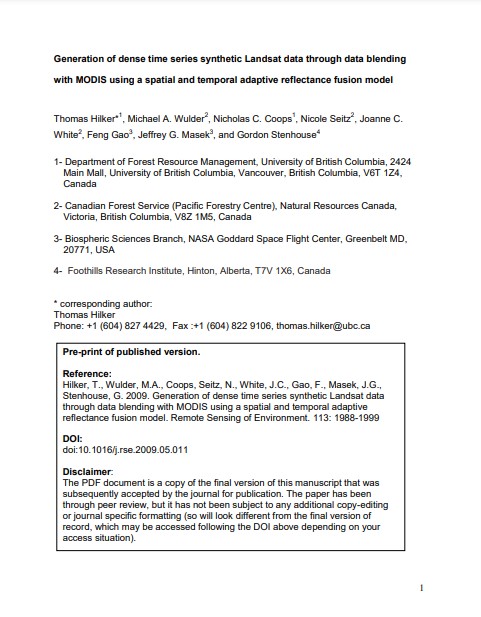Generation of dense time series synthetic Landsat data through data blending with MODIS using a spatial and temporal adaptive reflectance fusion model
Bosque Modelo:
Foothills
Temática:
Gestión forestal
Tipo de documento:
Artículo científico
Resumen
Landsat imagery with a 30 m spatial resolution is well suited for characterizing landscape-level forest structure and dynamics. While Landsat images have advantageous spatial and spectral characteristics for describing vegetation properties, the Landsat sensor's revisit rate, or the temporal resolution of the data, is 16 days. When considering that cloud cover may impact any given acquisition, this lengthy revisit rate often results in a dearth of imagery for a desired time interval (e.g., month, growing season, or year) especially for areas at higher latitudes with shorter growing seasons. In contrast, MODIS (MODerate-resolution Imaging Spectroradiometer) has a high temporal resolution, covering the Earth up to multiple times per day, and depending on the spectral characteristics of interest, MODIS data have spatial resolutions of 250 m, 500 m, and 1000 m. By combining Landsat and MODIS data, we are able to capitalize on the spatial detail of Landsat and the temporal regularity of MODIS acquisitions. In this research, we apply and demonstrate a data fusion approach (Spatial and Temporal Adaptive Reflectance Fusion Model, STARFM) at a mainly coniferous study area in central British Columbia, Canada.
Información Bibliográfica
Autor:
Hilker, T, MA Wulder, NC Coops, N Seitz, JC White, F Gao, JG Masek and G Stenhouse.
Revista:
Remote Sensing of Environment
Año:
2009
N°:
-
País :
Canadá
Páginas:
1988 - 1999
Volumen:
113
Idioma:
Ingles
Palabras claves
Landsat, MODIS, synthetic imagery, STARFM, data blending, EOSD Submitted to: Remote Sensing of Environment





